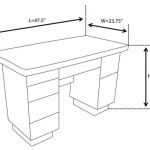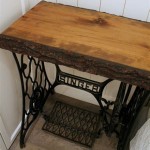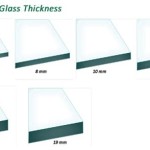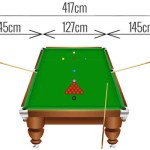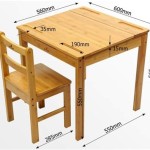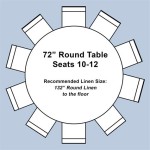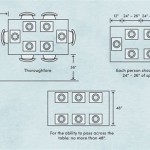Proper Table Setting for a Dinner Party
A well-set table is an integral part of any successful dinner party. It elevates the dining experience, communicates respect for the guests, and sets the tone for the entire event. While the specifics may vary depending on the formality of the occasion and the courses being served, there are fundamental principles that underpin a proper table setting. Understanding these principles allows hosts to confidently create an inviting and functional dining space.
The arrangement of tableware isn't merely aesthetic; it's a reflection of the anticipated flow of the meal. Each item is purposefully placed to facilitate ease of use and to guide guests through the courses. A properly set table demonstrates attention to detail and thoughtfulness, contributing significantly to the overall atmosphere of the dinner party.
Key Point 1: The Basic Elements of a Place Setting
A standard place setting, suitable for a multi-course meal, consists of several essential components. These include the dinner plate, flatware (forks, knives, and spoons), glassware (water glass, wine glass), and napkins. The placement of each element follows a specific logic, prioritizing the order in which they will be used during the meal.
The dinner plate serves as the foundation of the setting and is typically placed in the center of the individual dining space. Serving plates for subsequent courses will be placed on top of the dinner plate as needed. The dinner plate should be clean and free of any blemishes. Underneath the dinner plate, a charger plate can be added to add visual and aesthetic value. The charger plate is often placed before the first course arrives and removed before the main course.
Flatware is arranged around the plate, following the “outside-in” rule. This means that the utensils used for the first course are placed furthest from the plate, with each subsequent utensil closer to the plate in the order they will be used. Forks are placed to the left of the plate, with the salad fork (if applicable) on the outermost left, followed by the dinner fork. Knives are placed to the right of the plate, with the blade facing the plate. The spoons (teaspoon, soup spoon) are placed to the right of the knives. If a bread plate is provided, it is positioned above the forks on the left. A butter knife is placed horizontally on the bread plate.
Glassware is positioned above and to the right of the plate. The water glass is placed directly above the knife. If wine is being served, the wine glass (or glasses, if multiple wines are being served) is placed to the right of the water glass. The placement of glassware depends on the variety of drinks to be enjoyed. For a cocktail party, a cocktail glass may be pre-set, while for a formal dinner, specific wine glasses for red and white wine might be present.
The napkin is typically placed to the left of the forks or on top of the dinner plate. The choice depends on personal preference and the formality of the event. Elaborate folds can add a touch of elegance, but simplicity is often preferred for a more relaxed atmosphere. Alternatively, the napkin can be placed to the side of the place setting. The option should be selected to complement the overall theme of the event.
Key Point 2: Formal vs. Informal Table Settings
The level of formality dictates the complexity of the table setting. A formal dinner party requires a more elaborate setting than a casual gathering. Understanding the nuances of each style is crucial for creating the appropriate ambiance.
A formal table setting involves a greater number of utensils and glassware to accommodate multiple courses. Serving pieces are often more ornate, and attention to detail is paramount. Extra elements, such as place cards and individual salt and pepper cellars, may be included. The space between guests should also be considered. A more formal setting needs more space between the guest to avoid accidental bumping.
In a formal setting, a charger plate is almost always used beneath the dinner plate. Several forks would be present, including a salad fork, a fish fork (if fish is on the menu), and a dinner fork. The knives would include a dinner knife and a butter knife (on the bread plate). Several glasses would be present, including a water glass, a white wine glass, a red wine glass, and potentially a champagne flute if a toast is planned. A formal setting also includes a dessert fork and spoon, which may be brought out with the dessert course or pre-set above the dinner plate.
The linen used in a formal setting is typically of high quality, and elaborate folds for the napkins are common. Centerpieces are generally more elaborate but should never obstruct the view or conversation across the table. The color palette should be carefully considered to create a cohesive and elegant aesthetic.
An informal table setting is more relaxed and streamlined. Fewer utensils and glasses are used, and the overall presentation is less rigid. The focus is on creating a comfortable and welcoming environment for guests.
In an informal setting, a charger plate is not typically used. There may only be one fork and knife, suitable for the main course. A single glass might suffice for water and wine, or separate glasses can be used if desired. The napkin can be placed casually to the left of the plate or on top of it, and simple folds are preferred. The linen use can be simpler and more casual. It can be matched to the theme. For example, if it is a garden party, floral prints can be considered.
Centerpieces are often less elaborate, perhaps consisting of a simple vase of flowers or a bowl of fruit. The overall aesthetic is more relaxed and inviting, encouraging conversation and a sense of camaraderie.
Key Point 3: Course-Specific Tableware
Certain courses require specific tableware to ensure ease of consumption and to enhance the dining experience. Matching tableware to the intended course demonstrates thoughtful planning and attention to detail.
Soup is typically served in a bowl, which is placed on a service plate. A soup spoon, with its rounded bowl, is used for eating soup. Once finished, the soup bowl and service plate are removed together.
Salad is typically served on a smaller plate than the dinner plate. A salad fork, which may have a wider tine for cutting lettuce, is used for eating salad. If the salad is served after the main course, the salad plate is brought out after the dinner plate has been cleared.
Fish is often served with a specialized fish fork and knife. The fish fork is designed with a wider, flatter tine for separating the fish from the bones. The fish knife is often blunt and designed to help separate the fish without cutting it. These utensils are placed in the appropriate position if fish is a designated course.
Dessert is typically served with a dessert fork and spoon. These utensils are often smaller than the dinner fork and spoon. They are typically placed above the dinner plate or brought out with the dessert course. The dessert spoon can be used for creamy desserts or ice cream, while the dessert fork is used for cakes and pastries.
Coffee or tea service often includes a small cup and saucer, along with a teaspoon. These are typically brought out after dessert and placed to the right of the guest. Sugar and cream are offered separately.
Consideration should also be given to serving dishes. Serving dishes should be appropriate in size and material for the food being served. For example, hot dishes served in a bowl should be in a bowl that can sustain heat. Serving spoons and forks should also be provided for each dish.
In addition to the basic elements and course-specific tableware, there are several optional items that can be included in a table setting to enhance the dining experience. Place cards can be used to assign seating arrangements, adding a touch of formality and organization. Individual salt and pepper cellars add a touch of personalization and allow guests to season their food to their liking. Bread plates and butter knives are essential for any meal that includes bread service. Candle holders can be strategically placed to create a warm and inviting ambiance. All the elements chosen could affect the overall mood of the event.
Ultimately, the goal of a proper table setting is to create a functional and aesthetically pleasing dining space that enhances the dining experience for the guests. By understanding the basic principles and adapting them to the specific occasion, hosts can confidently create a table setting that is both elegant and welcoming.

Table Setting Rules You Should And Shouldn T Follow

How To Set The Perfect Dinner Party Table Home Style

How To Set A Table From Formal Casual Dining Architectural Digest

How To Set A Beautiful Formal Table It S Easy Mantel And

Setting A Proper Dinner Table
How To Set A Table Place Setting Guide Robert Welch Designs Ltd

Cheat Sheet How To Set A Table Tea Settings Proper Place Setting

How To Set The Perfect Dinner Party Table Home Style

Important Tips For Setting Up A Formal Dinner Table Sparklinglala

Pick Your Dinner Party Guests Then Decide On The Serveware Tablescapes
Related Posts

